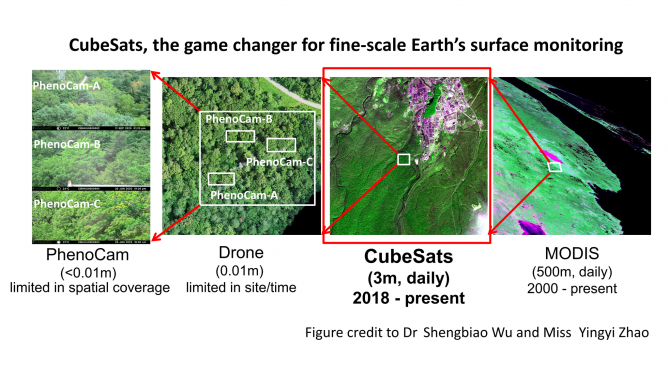Media
HKU environmental scientists solve key observational issues
in new generation of satellites, transforming the way to track fine-scale changes of our planet from space
02 Sep 2021

CubeSats serve as a bridge between proximate remote sensing measurements of phenocam and drone surveys (enabling fine-scale monitoring but with very limited coverage) and MODIS satellite measurements (enabling global monitoring but with very coarse resolution). (Figure credit: Dr Shengbiao WU and Miss Yingyi ZHAO)
Our Earth has experienced rapid environmental changes tightly tied to anthropogenic activities. Satellite remote sensing offers a quantitative means to monitoring such changes but is often limited to coarse spatial or temporal resolutions. Only very recently, the arrival of Planet’s Dove satellites, a constellation of CubeSats that are made of 190+ satellite sensors to produce daily and global coverage at a 3-meter resolution, offers an unprecedented opportunity for fine-scale Earth’s surface monitoring.
However, several issues remain with CubeSat observations that further hinder its broader applications: 1) Frequent clouds and cloud shadows often contaminate the satellite signal, 2) CubeSat observations source from 190+ satellite sensors with varying sun angles, causing the data inconsistency issue across different sensors, and 3) accurate biophysical interpretation of satellite signal remains lacking.
Dr Jin WU and Dr Jing WANG from Global Ecology and Remote Sensing (GEARS) Lab at the School of Biological Sciences, The University of Hong Kong (HKU), conducted a few research address to the above issues by developing novel observational methods that provide better accuracy on tracking fine-scale changes from space.
For example, the team has recently developed an automatic cloud and cloud shadow screening method for CubeSats, which leverages the spatial and temporal information of satellite reflectance bands, and has been demonstrated to enable cloud and shadow screening with the highest accuracy and least sensitivity to land cover type. The research outcome thus advances the monitoring of atmospheric cloud covers, while improving the data quality assessments for land-surface monitoring and biophysical extraction; the research has recently been published in scientific journal Remote Sensing of Environment (RSE).
Besides, the team has put much effort in recent years into improving the processing and interpretation of CubeSats. For example, to improve its data consistency over space and time, the team developed a rigorous method to cross-calibrate CubeSats to the same level as a more stable single-sensor satellite - Moderate Resolution Imaging Spectroradiometer (MODIS), that has been rigorously calibrated with sun-sensor geometry issues and demonstrated with consistently high data quality. In order to perform a direct and accurate biophysical interpretation from space, the team proposed a spectral unmixing approach that effectively classified the forest canopy into leafy vs leafless phenophases, from which it would enable fine-scale accurate phenology monitoring of tropical forests. Similarly, by integrating proximate drone surveys with CubeSats, the team demonstrated the feasibility to monitor plant phenology at the tree-crown scale.
“Our research has made significant observational advances to make full use of these new-generation satellite data, and ultimately facilitate the monitoring of Earth’s environmental changes, especially for those rapid and fine-scale changes,” said Dr Jing Wang, the leading author of the two journal papers published in RSE.
“There have been a series of papers in RSE on similar topics. Our work is not another one, but a new attempt to explore the possibility to enable satellite techniques for crown-scale phenology monitoring, which thus represents the cutting-edge research frontier and also opens a world of possibilities for individual-based ecology studies using satellite techniques,” added Dr Jin Wu, Principal Investigator of Global Ecology and Remote Sensing (GEARS) Lab at HKU.
With these advances, in the next step, the GEARS lab is aiming to leverage CubeSats and other geospatial technologies to facilitate the relevant research fields, which include but are not limited to ecological scaling principles, biodiversity research, forest growth, health, and management practices, climate change impact assessments and mitigation strategies, and ultimately the nature-based solutions to reaching carbon neutral goals.
The latest findings can be accessed from the following links:
Automatic cloud and cloud shadow detection in tropical areas for PlanetScope satellite images:
https://doi.org/10.1016/j.rse.2021.112604
Other related journal papers can be accessed from the following links:
Multi-scale integration of satellite remote sensing improves characterization of dry-season green-up in an Amazon tropical evergreen forest:
https://doi.org/10.1016/j.rse.2020.111865
Monitoring tree-crown scale autumn leaf phenology in a temperate forest with an integration of PlanetScope and drone remote sensing observations:
https://doi.org/10.1016/j.isprsjprs.2020.10.017
Images download and captions: https://www.scifac.hku.hk/press
For media enquiries, please contact Ms Casey To, External Relations Officer(tel: 3917 4948; email: caseyto@hku.hk) / Ms Cindy Chan, Assistant Director of Communications of HKU Faculty of Science (tel: 3917 5286; email: cindycst@hku.hk)
